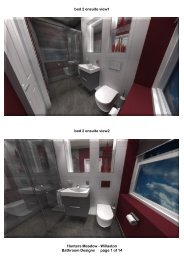Lon Ednyfed Criccieth
Bryn Eglwys is a grandiose Detached Victorian Period Residence located in a superb and highly desirable position within the picturesque coastal village of Criccieth, enjoying an excellent southerly aspect with splendid far reaching sea views, including Criccieth castle and the striking Cambrian coastline on the far side of Tremadog Bay.
Bryn Eglwys is a grandiose Detached Victorian Period Residence located in a superb and highly desirable position within the picturesque coastal village of Criccieth, enjoying an excellent southerly aspect with splendid far reaching sea views, including Criccieth castle and the striking Cambrian coastline on the far side of Tremadog Bay.
You also want an ePaper? Increase the reach of your titles
YUMPU automatically turns print PDFs into web optimized ePapers that Google loves.
<strong>Criccieth</strong> is a town and community on the Llyn peninsula in the Eifionydd area of Gwynedd in Wales. The town lies 5 miles (8 km) west of Porthmadog, 9 miles (14 km) east<br />
of Pwllheli and 17 miles (27 km) south of Caernarfon. It had a population of 1,826 in 2001, reducing to 1,753 at the 2011 census. The town is a seaside resort, popular with<br />
families. Attractions include the ruins of <strong>Criccieth</strong> Castle, which have extensive views over the town and surrounding countryside. Nearby on Ffordd Castell (Castle Way) is Cadwalader's<br />
Ice Cream Parlour, opened in 1927, whilst Stryd Fawr (High Street) has several bistro-style restaurants. In the centre lies Y Maes ("The Field", or town square), part of<br />
the original medieval town common. The town is noted for its fairs, held on 23 May and 29 June every year, when large numbers of people visit the fairground and the market<br />
which spreads through many of the streets of the town. Famous people associated with the town include the British prime minister, David Lloyd George, who grew up in the<br />
nearby village of Llanystumdwy, and poet William George. Group Captain Leslie Bonnet, RAF officer, writer and originator of the Welsh Harlequin Duck and his wife Joan<br />
Hutt, artist both lived at Ymwlch just outside <strong>Criccieth</strong> from 1949 until their deaths in 1985. <strong>Criccieth</strong> hosted the National Eisteddfod in 1975 and in 2003 was granted<br />
Fairtrade Town status. It won the Wales in Bloom competition each year from 1999 to 2004. <strong>Criccieth</strong> Castle dominates the town, standing on a rock overlooking Cardigan Bay.<br />
Little survives of the original building, but the outer defences are still prominent. The inner bailey contains the earliest remains, including the inner gatehouse, which has two<br />
semi-circular towers. It is thought that the original living quarters were in the south west tower, overlooking the sea, and that the square north tower supported a catapult. To<br />
the south of Y Maes stands Caffi Cwrt, an early 18th century detached stone house where the burgesses held court when rain prevented them meeting in their usual location<br />
on the bridge. The house has been owned by just two families since 1729. Two medieval strip fields to the rear, Llain Fawr (large strip) and Llain Bella (furthest strip), formed<br />
most of the smallholding of Cwrt but were lost when the railway was built. Nearby, where the slate shop now stands, was a smithy. On Penpaled Road is a cottage, Penpaled,<br />
built in 1820 on a plot lying between two enclosed meadows. The meadows, Cae'r Beiliaid (bailiff's field) and Llain y Beiliaid (bailiff's strip) were subsequently to form part of the<br />
route of both the road and the railway. Further uphill stand a 17th-century whitewashed cottage, Ty'r Felin, and Foinavon, a yellow pebble-dashed building once owned by the<br />
Bird's Custard family. Morfin, on Tan-y-Grisiau Terrace was used as an office by David Lloyd George whilst he was practising as a solicitor. Nearby, Ty Newydd, a mid-16th century<br />
house, was originally built to house the estate bailiff. <strong>Criccieth</strong>'s first council houses on the adjacent Henbont Road were built on land donated to rehouse families made<br />
homeless by the 1927 storm. Three 600-year-old cottages, originally thatched, make up Wellington Terrace. They are thought to be the oldest in the town. Ffordd Castell is<br />
within Yr Hen Dref, the original settlement. Ffordd Castell is within the original settlement, Yr Hen Dref, though most of the houses are Victorian. Ty Mawr, however, originally a<br />
smallholding and later a public house, dates from the 16th century, whilst on the opposite side of the street a long stone building, divided into three cottages, Porth yr Aur, Trefan<br />
and Cemlyn, dates from 1700. The Castle Bakery next door features a stained glass insertion above the shop window which depicts bakers at work. In the past nearby residents<br />
could bring their own dough to be baked in the ovens. By the castle entrance Gardd y Stocs, a small green, was home to the town's stocks, whilst the building that houses<br />
the castle information centre was part of the town's guildhall. The heart of the old town is Y Dref. It was here that the weekly market was held, and it was also the venue for<br />
numerous political meetings. Edward I granted lands north of the borough to the Bishop of Bangor, and it is thought that Gardd yr Esgob on Lôn Bach formed part of these. In<br />
the 19th century one of the town's abattoirs stood here. Tan y Graig, a house at the end of a long garden, dates from at least 1800. Three 16th century fishermen's cottages<br />
stand in Rock Terrace. Named Sea Winds, Ty Canol and Ty Isaf, they have 14th century foundations. On the green at West Parade stands a shelter donated by Margaret Lloyd<br />
George, the wife of the former prime minister. David Lloyd George practised as a solicitor in <strong>Criccieth</strong>, and, before the First World War, lived at Bryn Awelon.Muriau on Lôn<br />
Fel includes a group of partly 17th century farm buildings set around a square, which were converted into houses by Elizabeth Williams Ellis of Chwilog. Muriau Poethion contains<br />
an early spiral staircase going round a large inglenook fireplace. North of Ffordd Pwllheli, several mansions are along the lane, now named Lôn Fel Uchaf. Parciau was once<br />
owned by Ellis Annwyl Owen, rector of Llanystumdwy from 1837 to 1846, whilst Parciau Mawr has a notable 19th century hay barn. Bryn Awelon was the home of David Lloyd<br />
George before the First World War, and later of his daughter Megan. Nearby, on Arfonia Terrace, is Parciau Uchaf, a farmhouse dating from 1829. Y Gorlan on Ffordd Caernarfon<br />
formed part of the small estate of Cefniwrch Bach, a hunting lodge for Edward I at the time the castle was being built, and is thought to have been a tannery in medieval times.<br />
Ger y Maes, the end house on Holywell Terrace, is close to an ancient well, Ffynnon y Saint, which supplied much of the town's water. The house had a spring inside a cupboard,<br />
and ginger beer was manufactured and sold. The house at the opposite end of the terrace was a dairy, and to the south are the ruins of the former animal pound, where stray<br />
animals were held before being sold. The former National Westminster Bank on Stryd Fawr has step gables and is a duplicate of a building at Talgarth in Powys. On the south side<br />
of the street are a number of 19th century shops, including the Medical Hall, dating from 1875 and Siop Newydd, built in 1869. At the eastern end of the Esplanade stands the<br />
Morannedd Café, built in 1954 by Clough Williams-Ellis. Talhenbont Hall is a Grade II listed manor house. It was built in 1607 was once the home of William Vaughan. In 1642,<br />
the owner William Lloyd was arrested as a Royalist sympathiser as Cromwell's men took over the hall. In 1758 Talhenbont was the largest single owned piece of land in the<br />
district of Eifionydd. The estate was occupied by Sir Thomas Mostyn, the sixth baronet, from 1796. In 1884 the estate was split into sections to pay off debts that had crept up<br />
during the Napoleonic Wars. It is now operated as a holiday centre.
















